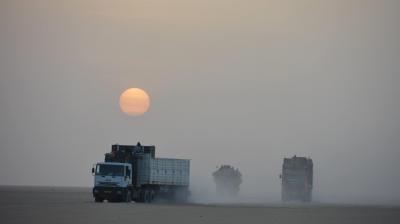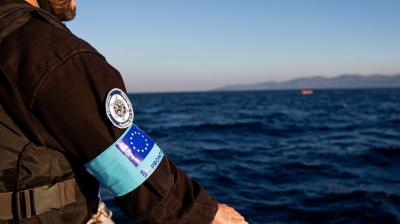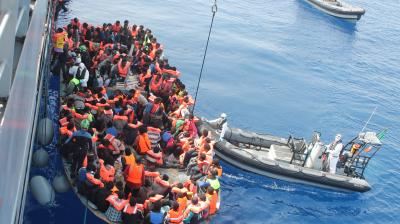EU Migration Policies in the Sahel-Stagnation in a Mode of Crisis
This commentary is part of a series of four on 'European migration management - lessons learned'.
Introduction
Acknowledging that migration is a responsibility shared between countries of origin, transit and destination, European and African leaders adopted the Joint Valletta Action Plan (JVAP) in 2015. The JVAP is based on five goals: addressing the root causes of irregular migration and forced displacement; enhancing cooperation on regular migration and mobility (legal pathways); reinforcing the protection of migrants and asylum seekers; fighting irregular migration, human smuggling and trafficking; and improving cooperation on return, readmission and reintegration. Yet three years down the line, managing migration appears to be understood mainly as fighting irregular migration. This is a short-term strategy with dangerous consequences for the region.
Legal pathways as an alternative to irregular migration
Over the last few years, the EU has taken some steps to provide alternatives to irregular migration. To this end, the Commission has proposed a revised EU Blue Card scheme for highly skilled workers and adopted an EU resettlement scheme for refugees. In addition, the EU has launched a new ‘Africa-Europe Alliance for Sustainable Investment and Jobs’, aiming for the creation of jobs in Africa, but also investing in the mobility of students through the Erasmus+ Programme and the creation of a free trade agreement between the EU and Africa enhancing economic mobility. Yet, despite the relevant legal frameworks in place at EU and Member State level to facilitate legal pathways for workers, researchers and vulnerable groups, the topic does not enjoy broad political support and implemented initiatives remain small-scale.
At multilateral level, legal pathways for refugees have become more constricted. The UNHCR resettlement scheme provides relief for those refugees who have particular needs or vulnerabilities in their country of asylum and cannot return to their country of origin. UNHCR resettlement refers to the relocation of refugees from a state where they have sought protection to a third state that has agreed to admit them as refugees with permanent residence status. However, due to fluctuations in state quotas for resettlement, in 2017 UNHCR faced a 54% drop in resettlement places provided by states compared to 2016. In addition, the number of states accepting UNHCR submissions has decreased from 35 in December 2017 to 27 by the end of September 2018.
"At multilateral level, legal pathways for refugees have become more constricted."
This illustrates that, in parallel with the continued focus on border management to eradicate irregular migration, no credible alternatives to these irregular movements are provided. As long as there is a lack of legal pathways of significant scale, reliance on irregular migration is set to continue, feeding into the business model of human smugglers, driving up costs for smuggling services and causing migration routes to divert to more hazardous journeys.
Niger: Arena for persistent securitised migration management
In the light of the EU’s and Member States’ dominant interests in reducing migration arrivals, the Valletta Action Plan’s pillar on “fighting irregular migration” has been implemented forcefully in Niger – the key transit state along the Central Mediterranean Migration Route. Despite the official decrease of 95% in migration movements, both multilateral and bilateral engagements continue to rely on security-focused initiatives. These initiatives follow in the footsteps of the EU capacity-building mission EUCAP Sahel Niger, whose mandate to control irregular migration movements was extended – exemplifying the integration of EU migration policies into its security and defence policy.
In a context of increasing cross-border displacement from northern Nigeria into Niger, this approach has been directed further south. Funding pledged to EUCAP Sahel Niger by Germany and the Netherlands is set to provide for the establishment of a Nigerien police force to control its border with Nigeria. Under the EUCAP mandate, the new force will deploy to the regions of Maradi and Birn’in Konni in contingents of 250 in each case to control cross-border migration and crime.
Against this background, the European Border and Coast Guard – created in 2016 as a successor to Frontex, is simultaneously institutionalising the EU’s migration management approach further south. The EU commission’s recent proposal to develop an operational staff of 10,000 sets the agency on a path to becoming a more independent actor in the EU’s externalisation approach by extending the scope of deployment to countries outside the EU’s direct neighbourhood.
At the level of Member States, approaches to fighting irregular migration have similarly gained further traction – with Italy proving a prominent case in point. Following its spotlight on Libya as a key transit state, Italy's recent strategic foreign policy shift to the Sahel has focused on Niger, culminating in the deployment of military troops through its “Bilateral support mission in the Republic of Niger” (MISIN). The deployment follows a nine-month blockage by the Nigerien government, highlighting the sensitive nature of a further military mission in a country already rife with foreign interventions. MISIN is setting a precedent as both Italy’s first military deployment in the Sahel and simultaneously the first military mission in the region to focus explicitly on stemming irregular migration. However, the deployment adds to existing missions; France is present in the Sahel with Operation Barkhane, as are the EU’s capability-training mission in Niger (EUCAP Sahel Niger), a recently inaugurated German military air base and an ever-growing US presence. MISIN thereby underlines the pertinence of Niger as an arena of strategic positioning.
"At the level of Member States, approaches to fighting irregular migration have similarly gained further traction – with Italy proving a prominent case in point."
In this sense, MISIN can be considered not only a tool to further control migratory flows in southern Libya but also an Italian instrument to gain a military footprint in the Sahel. However, in a region traditionally regarded as a strategic zone of influence of France, this has met with opposition. Against the background of heightened competition between the two countries in dealing with Libya, the Nigerien government – amid rising local discontent and apparently influenced by France – proved unwilling to give ground to Italian ambitions. Consequently, rather than joining French troops in their northern outpost of Madama as envisioned, only 80 km south of the Libyan border, MISIN is instead confined to Niamey. Now more than 1,500 km away from Niger’s northern border, Italy thus finds itself in a position far from its original goal, where it has little control over any migration movements at all.
On the ground, the spillover of bilateral competition between Italy and France over Libya to Niger has demonstrated the dangers of a securitised approach through exacerbating existing local grievances and ethnic cleavages. As a result of an expected Italian deployment to northern Niger, Tubu militias anticipating a competition for foreign funding to contain migration movements sought financial support from French forces. The example of Italy thus serves as a reminder of the extent to which military deployments in the region spur militias to present themselves as allies in the EU’s fight against irregular migration. In a region rife with conflict and instability, this development may contribute to the further undermining of the state in peripheral regions.
Conclusion
The 2015 crisis mode of European policy-makers focusing on bringing down the number of arrivals in the short term appears to have become a permanent strategy of migration management. Three years after adoption of the JVAP, EU and Member States alike continue to rely on security interventions to curb irregular migration flows. This commentary argues that this approach is not sustainable: existing local grievances, increasing competition and tensions between tribal groups and the expanding number of European countries intervening in the Sahel exemplify this. However, in the absence of regular channels, migration from the African continent will continue to rely on irregular migration movements. This underlines the importance of implementing the second pillar of the JVAP: offering legal pathways as an alternative to irregular migration.










